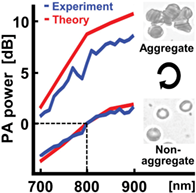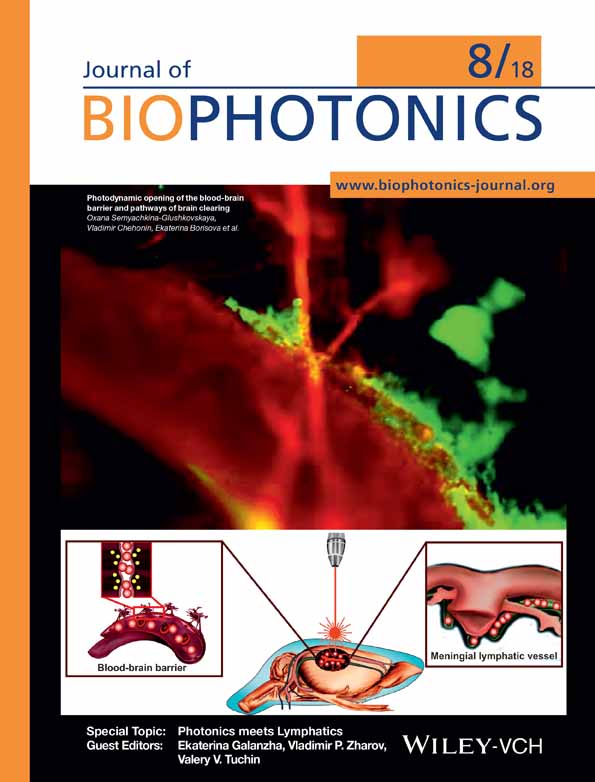In vitro photoacoustic spectroscopy of pulsatile blood flow: Probing the interrelationship between red blood cell aggregation and oxygen saturation
Tae-Hoon Bok
Department of Physics, Ryerson University, Toronto, Ontario, Canada
Institute for Biomedical Engineering, Science and Technology (iBEST), Toronto, Ontario, Canada
Keenan Research Centre for Biomedical Science of St. Michael's Hospital, Toronto, Ontario, Canada
Search for more papers by this authorEno Hysi
Department of Physics, Ryerson University, Toronto, Ontario, Canada
Institute for Biomedical Engineering, Science and Technology (iBEST), Toronto, Ontario, Canada
Keenan Research Centre for Biomedical Science of St. Michael's Hospital, Toronto, Ontario, Canada
Search for more papers by this authorCorresponding Author
Michael C. Kolios
Department of Physics, Ryerson University, Toronto, Ontario, Canada
Institute for Biomedical Engineering, Science and Technology (iBEST), Toronto, Ontario, Canada
Keenan Research Centre for Biomedical Science of St. Michael's Hospital, Toronto, Ontario, Canada
Correspondence
Michael C. Kolios, Department of Physics, Ryerson University, 350 Victoria Street, Toronto, Ontario M5B 2K3, Canada.
Email: [email protected]
Search for more papers by this authorTae-Hoon Bok
Department of Physics, Ryerson University, Toronto, Ontario, Canada
Institute for Biomedical Engineering, Science and Technology (iBEST), Toronto, Ontario, Canada
Keenan Research Centre for Biomedical Science of St. Michael's Hospital, Toronto, Ontario, Canada
Search for more papers by this authorEno Hysi
Department of Physics, Ryerson University, Toronto, Ontario, Canada
Institute for Biomedical Engineering, Science and Technology (iBEST), Toronto, Ontario, Canada
Keenan Research Centre for Biomedical Science of St. Michael's Hospital, Toronto, Ontario, Canada
Search for more papers by this authorCorresponding Author
Michael C. Kolios
Department of Physics, Ryerson University, Toronto, Ontario, Canada
Institute for Biomedical Engineering, Science and Technology (iBEST), Toronto, Ontario, Canada
Keenan Research Centre for Biomedical Science of St. Michael's Hospital, Toronto, Ontario, Canada
Correspondence
Michael C. Kolios, Department of Physics, Ryerson University, 350 Victoria Street, Toronto, Ontario M5B 2K3, Canada.
Email: [email protected]
Search for more papers by this authorAbstract
We investigate the optical wavelength dependence in quantitative photoacoustic (QPA) assessment of red blood cell (RBC) aggregation and oxygen saturation (sO2) during pulsatile blood flow. Experimentally, the pulsatile flow was imaged with a 700 to 900 nm laser using the VevoLAZR. Theoretically, the photoacoustic (PA) signals were computed based on a Green's function integrated with a Monte Carlo simulation of radiant fluence. The pulsatile flow created periodic conditions of RBC aggregation/nonaggregation, altering the aggregate size, and, in turn, the sO2. The dynamic range, DR (a metric of change in PA power) from 700 to 900 nm for nonaggregated RBCs, was 5 dB for both experiment and theory. A significant difference in the DR for aggregated RBCs was 1.5 dB between experiment and theory. Comparing the DR at different wavelengths, the DR from nonaggregated to aggregated RBCs at 700 nm was significantly smaller than that at 900 nm for both experiment (4.0 dB < 7.1 dB) and theory (5.3 dB < 9.0 dB). These results demonstrate that RBC aggregation simultaneously affects the absorber size and the absorption coefficient in photoacoustic imaging (PAI) of pulsatile blood flow. This investigation elucidates how QPA spectroscopy can be used for probing hemodynamics and oxygen transport by PAI of blood flow.

Supporting Information
| Filename | Description |
|---|---|
| jbio201700300-sup-0001-author-biographies.docxWord document, 536.5 KB | Author Biographies |
Please note: The publisher is not responsible for the content or functionality of any supporting information supplied by the authors. Any queries (other than missing content) should be directed to the corresponding author for the article.
REFERENCES
- 1O. K. Baskurt, H. J. Meiselman, Clin. Hemorheol. Microcirc. 2013, 53, 23.
- 2F. T. H. Yu, J. K. Amstrong, J. Tripette, H. J. Meiselman, G. Cloutier, J. Thromb, Haemostasis 2011, 9, 481.
- 3Q. Li, L. Li, Y. Li, J. Clin. Lab. Anal. 2015, 29, 387.
- 4T.-H. Bok, Q. Kong, K.-H. Nam, Y. H. Oh, J. G. Kim, J. J. Lee, J. C. Choi, D.-G. Paeng, IEEE International Ultrasonics Symposium Proceedings, IEEE, Dresden, 2012, p. 2364.
- 5K. R. Walley, Am. J. Respir. Crit. Care Med. 2011, 184, 514.
- 6J. V. Pope, A. E. Jones, D. F. Gaieski, R. C. Arnold, S. Trzeciak, N. I. Shapiro, Ann. Emerg. Med. 2010, 55, 40.
- 7A. E. Jones, N. I. Shapiro, S. Trzeciak, R. C. Arnold, H. A. Claremont, J. A. Kline, JAMA 2010, 303, 739.
- 8K. K. Tremper, Chest 1989, 95, 713.
- 9T. Aoyagi, J. Anesth. 2003, 17, 259.
- 10T.-H. Bok, Y. Li, K.-H. Nam, J. C. Choi, D.-G. Paeng, J. Med. Biol. Eng. 2015, 35, 21.
- 11M. G. M. de Kroon, C. J. Slager, W. J. Gussenhoven, P. W. Serruys, J. R. T. C. Roelandt, N. Bom, Ultrasound Med. Biol. 1991, 17, 723.
- 12G. Cloutier, Z. Qin, Biorheology 1997, 34, 443.
- 13C.-C. Huang, I.E.E.E. Trans. Biomed. Eng. 2011, 58, 1163.
- 14K. K. Shung, IEEE Trans. Ultrason. Ferroelectr. Freq. Control 1982, SU-26, 327.
- 15D.-G. Paeng, K.-H. Nam, K. K. Shung, Ultrasound Med. Biol. 2010, 36, 1118.
- 16F. L. Lizzi, M. Ostromogilsky, E. J. Feleppa, M. C. Rorke, M. M. Yaremko, IEEE Trans. Ultrason. Ferroelectr. Freq. Control 1986, 34, 319.
- 17E. Bianconi, A. Piovesan, F. Facchin, A. Beraudi, R. Casadei, F. Frabetti, L. Vitale, M. C. Pelleri, S. Tassani, F. Piva, S. Perez-Amodio, P. Strippoli, S. Canaider, Ann. Hum. Biol. 2013, 40, 463.
- 18F. T. H. Yu, G. Cloutier, J. Acoust. Soc. Am. 2007, 122, 645.
- 19V. Twersky, J. Acoust. Soc. Am. 1987, 81, 1609.
- 20L. Y. L. Mo, R. S. C. Cobbold, in Ultrasonic Scattering in Biological Tissues (Eds: K. K. Shung, G. A. Theieme), CRC, Boca Ranton, FL 1993, Ch. 5.
- 21F. F. Jöbsis, Science 1977, 198, 1264.
- 22P. W. McCormick, M. G. Goetting, G. Balakrishnan, Stroke 1991, 22, 596.
- 23G. Mardirossian, R. E. Schneider, Anesth. Prog. 1992, 39, 194.
- 24X. Wang, X. Xie, G. Ku, L. V. Wang, G. Stoica, J. Biomed. Opt. 2006, 11, 24015.
- 25H. F. Zhang, K. Maslov, M. Sivaramakrishnan, G. Stoica, L. V. Wang, Appl. Phys. Lett. 2007, 90, 53901.
- 26P. C. Beard, Interface Focus 2011, 1, 602.
- 27L. V. Wang, Med. Phys. 2008, 35, 5758.
- 28L. V. Wang, IEEE J. Sel. Top. Quantum Electron. 2008, 14, 171.
- 29L. V. Wang, L. Gao, Annu. Rev. Biomed. Eng. 2014, 16, 155.
- 30L. V. Wang, S. Hu, Science 2012, 335, 1458.
- 31 L. V. Wang Ed., Photoacoustic Imaging and Spectroscopy, CRC Press, Boca Raton, FL 2009.
- 32E. Hysi, R. K. Saha, M. C. Kolios, Biomed. Opt. Express 2012, 3, 2326.
- 33T.-H. Bok, E. Hysi, M. C. Kolios, Biomed. Opt. Express 2016, 7, 2769.
- 34F. L. Lizzi, E. J. Feleppa, S. K. Alam, C. X. Deng, Pattern Recognit. Lett. 2003, 24, 637.
- 35Y. Yang, S. Wang, C. Tao, X. Wang, X. Liu, Appl. Phys. Lett. 2012, 101, 034105.
- 36R. E. Kumon, C. X. Deng, X. Wang, Ultrasound Med. Biol. 2011, 37, 834.
- 37M. P. Patterson, C. B. Riley, M. C. Kolios, W. M. Whelan, J. Biomed. Opt. 2014, 19, 056008.
- 38G. Xu, Z.-X. Meng, J. D. Lin, J. Yuan, P. L. Carson, B. Joshi, X. Wang, Radiology 2014, 271, 248.
- 39G. Xu, J. B. Fowlkes, C. Tao, X. Liu, X. Wang, Ultrasound Med. Biol. 2015, 41, 1473.
- 40G. Xu, I. A. Dar, C. Tao, X. Liu, C. X. Deng, X. Wang, Appl. Phys. Lett. 2012, 101, 221102.
- 41B. T. Cox, J. G. Laufer, S. R. Arridge, P. C. Beard, J. Biomed. Opt. 2012, 17, 061202.
- 42E. Hysi, R. K. Saha, M. C. Kolios, J. Biomed. Opt. 2012, 17, 125006.
- 43T.-H. Bok, E. Hysi, M. C. Kolios, Proceedings of SPIE, SPIE, San Francisco, CA 2017, p. 100645F.
- 44S. L. Jacques, T. Li, Monte Carlo simulations of light transport in 3D heterogenous tissues (mcxyz.c), http://omlc.org/software/mc/mcxyz/index.html (accessed: May 2017).
- 45L. V. Wang, S. L. Jacques, L. Zheng, Comput. Methods Programs Biomed. 1995, 47, 131.
- 46M. Keijzer, S. L. Jacques, Lasers Surg. Med. 1989, 154, 148.
- 47J. Zalev, M. C. Kolios, Proceedings of SPIE, SPIE, San Francisco, CA 2011, p. 78992M.
- 48J. Zalev, M. C. Kolios, J. Acoust. Soc. Am. 2015, 137, 1675.
- 49Canadian Blood Services. netCAD Blood For Research Donor Eligibility, https://blood.ca/sites/default/files/netCADEligibility_EN.pdf (accessed: December 2017).
- 50O. K. Baskurt, M. Boynard, G. C. Cokelet, P. Connes, B. M. Cooke, S. Forconi, F. Liao, M. R. Hardeman, F. Jung, H. J. Meiselman, G. Nash, N. Nemeth, B. Neu, B. Sandhagen, S. Shin, G. Thurston, J. L. Wautier, Clin. Hemorheol. Microcirc. 2009, 42, 75.
- 51H.-J. Lim, J.-H. Nam, B.-K. Lee, J.-S. Suh, S. Shin, Korea-Aust. Rheol. J. 2011, 23, 67.
- 52A. Needles, A. Heinmiller, J. Sun, C. Theodoropoulos, D. Bates, D. Hirson, M. Yin, F. Foster, IEEE Trans. Ultrason. Ferroelectr. Freq. Control 2013, 60, 888.
- 53S. L. Jacques, Phys. Med. Biol. 2013, 58, R37.
- 54R. C. Smith, K. S. Baker, Appl. Optics 1981, 20, 177.
- 55G. J. Diebold, in Photoacoustic Imaging and Spectroscopy (Ed: L. V. Wang), CRC Press, Boca Raton, FL 2009, Ch. 1.
- 56B. T. Cox, P. C. Beard, J. Acoust. Soc. Am. 2005, 117, 3616.
- 57R. N. Bracewell, The Fourier Transform and its Applications, McGraw-Hill, Singapore 2000, p. 329.
- 58R. K. Saha, S. Karmakar, M. Roy, PLoS One 2012, 7, 1.
- 59T. L. Szabo, Diagnostic Ultrasound Imaging: Inside Out, Elsevier Academic Press, New York, NY 2004, p. 97.
10.1016/B978-012680145-3/50006-2 Google Scholar
- 60S.-H. Wang, K. K. Shung, I.E.E.E. Trans. Biomed. Eng. 1997, 44, 549.
- 61J. F. Greenleaf, Tissue Characterization with Ultrasound, Vol. 1, CRC Press, Boca Raton, FL 1986.
- 62J. F. Greenleaf, Tissue Characterization with Ultrasound, Vol. 2, CRC Press, Boca Raton, FL 1986.
- 63R. K. Saha, S. Karmakar, E. Hysi, M. Roy, M. C. Kolios, J. Biomed. Opt. 2012, 17, 055002.
- 64T.-H. Bok, E. Hysi, M. C. Kolios, IEEE International Ultrasonics Symposium Proceedings, IEEE, Chicago, IL, USA 2014, p. 1292.
- 65T.-H. Bok, E. Hysi, M. C. Kolios, Proceedings of SPIE, SPIE, San Francisco, CA 2015, p. 93231Q.
- 66T.-H. Bok, E. Hysi, M. C. Kolios, Proceedings of SPIE, SPIE, San Francisco, CA 2016, p. 97081M.
- 67N. Tateishi, Y. Suzuki, I. Cicha, N. Maeda, Am. J. Physiol. Heart Circ. Physiol. 2001, 281, H448.
- 68N. Tateishi, Y. Suzuki, M. Shirai, I. Cicha, N. Maeda, J. Biomech. 2002, 35, 1241.
- 69C.-C. Huang, IEEE Trans. Ultrason. Ferroelectr. Freq. Control 2009, 56, 1677.
- 70L. C. Nguyen, F. T. H. Yu, G. Cloutier, Ultrasound Med. Biol. 2008, 34, 664.
- 71F. T. H. Yu, É. Franceschini, B. Chayer, J. K. Armstrong, H. J. Meiselman, G. Cloutier, Biorheology 2009, 46, 343.
- 72R. K. Saha, E. Franceschini, G. Cloutier, J. Acoust. Soc. Am. 2011, 129, 2269.
- 73L. Allard, G. Cloutier, L.-G. Durand, IEEE Trans. Ultrason. Ferroelectr. Freq. Control 1996, 43, 211.
- 74Z. Qin, L.-G. Durand, L. Allard, G. Cloutier, Ultrasound Med. Biol. 1998, 24, 503.
- 75C. M. Moran, N. L. Bush, J. C. Bamber, Ultrasound Med. Biol. 1995, 21, 1177.
- 76H. Ding, J. Q. Lu, W. A. Wooden, P. J. Kragel, X. H. Hu, Phys. Med. Biol. 2006, 51, 1479.
- 77M. Larsson, H. Nilsson, T. Strömberg, Appl. Optics 2003, 42, 124.
- 78T.-H. Bok, E. Hysi, M. C. Kolios, IEEE International Ultrasonics Symposium Proceedings, IEEE, Washington, DC 2017.




